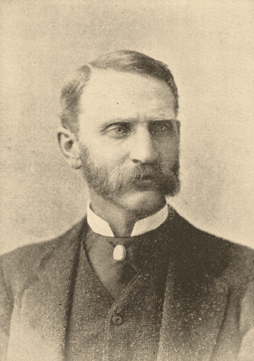
J.C. Hendershot, photograph published in 1889.
Violin by John C. Hendershot, Cleveland, Ohio, USA, 1887
Description — Aesthetic This violin is enchanting from all points of view. As you can see, the choice
of wood is breathtaking and the workmanship impeccable. I find the deeply-figured single-piece back
and matching ribs/head stunning. The table's wide, consistent grain (with
colors inverted) runs perfectly straight.
The soundholes, expertly proportioned, stand elegantly amidst a well-developed arch, full in the flanks.
Their design incorporates the best elements of the classical makers: long but not too pointy,
rounded but not flabby, neither too slender nor too open, leaning just slightly.
The notches draw tiny equilateral triangles.
The original, short neck was angled to reach a modern projection, but not reshaped.
The thin, fair varnish is beautifully clear,
letting light gleam into the highly reflective ground.
One can further appreciate fine purfling
 J.C. Hendershot, photograph published in 1889. Maker — To be Rediscovered There is scant information out there about John C. Hendershot (1846-1909).
I hope
someone someday will do the research this maker deserves.
From what I could gather, he came from a very musical family. His ancestor John Michael
Hendershot (1674-1749) who emigrated from Germany might have been a violin maker.
A good violinist himself,
J.C. started in the business by owning a large music store
in Cleveland where he also performed repairs.
Through his travels to Europe, he brought to the USA a fine collection of violins
including examples by Albani, Stainer, Amati, Guarneri and Stradivari.
At some point, he started making violins, copying those instruments.
He eventually became so proficient that international soloists,
such as Ede Reményi or Simon E. Jacobsohn,
came in to acquire his violins.
Tone — Radiant The tone is the best part of this Hendershot:
complex, lustrous, large, deep and dark, also fine and lovely like lace,
brilliant and glistening like sunshine on water.
Regardless of setup, its inherent ringing quality shines through.
Response is instantaneous and very clear, throughout the whole range.
What I especially appreciate is the
vibrations one feels playing it, it's like getting a massage. This fiddle vibrates into
your body as though it was using you as a sounding board.
It's so addictive that you don't want to stop playing.
Acquisition — A Lucky Strike I found this rare violin on eBay.com in 1999. Had never heard of the maker but
liked what I saw on the pictures. The final price was embarrassingly low, but
it had an open crack.
As a violin teacher, I occasionally
purchased instruments for my students, however this one was so outstanding I kept it. I wouldn't
recommend buying a violin on eBay — have had bad experiences —
nevertheless this Hendershot was a wonderful surprise.
Over the years, the more I've compared it with other violins, the more I've been blown away by its
tonal qualities. This is a special gem.
Strings — Complement vs. Compliment A fundamental question is whether to choose strings that compensate
for a violin's weaknesses or strings that emphasize the violin's peculiarities. Of
course, the ideal is both.
In this case, I've chosen Thomastik Vision Solo
to add flesh to the middle of the sound spectrum and even out the wolves, while pushing
its power towards even more glitter.
Bibliography More about J. C. Hendershot:
|
Measurements & Data
Maker: John Coryell Hendershot (1846-1909) Made in: Cleveland, Ohio, USA Year: 1887 Number: 169 Back Length: 359 mm * Upper Bouts: 167 mm * Middle Bouts: 111 mm * Lower Bouts: 208 mm * Stop Length: 193 mm Rib Height at Neck: 30 mm * Rib Height at Endpin: 31 mm * Thickness of the Top: 3.1 mm Thickness of the Back: 5.3 mm F-hole Length: 78.2 mm * Distance Between F-holes: 41.5 mm * Distance Edge-Purfling: 4.5 mm Scroll Width: 41 mm * Weight: 417 grams Label: J. C. HENDERSHOT, 724 Republic Street, CLEVELAND, OHIO. No169 1887 Condition: Several edge cracks on top, otherwise in excellent condition. Original neck. Restoration: Pierre Mastrangelo, Lausanne, Switzerland, 2000. * measured with a caliper |
||||||||||||||||||||||||||||||||||||||||